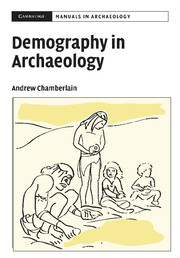Book contents
4 - ARCHAEOLOGICAL DEMOGRAPHY
Published online by Cambridge University Press: 02 December 2009
Summary
PAST POPULATION STRUCTURE
Background to the palaeodemography debate
Prior to the 1930s most studies of human palaeodemography relied on historical records such as commemorative inscriptions and censuses as sources of mortality and survivorship data. Following pioneering work by T. W. Todd (1920, 1924) on the timing of age-related changes in the adult human skeleton there emerged new opportunities to utilise anthropological data in palaeodemography (Acsádi and Nemeskéri, 1970: 51–57). Early applications of skeletal evidence for estimating age at death in palaeodemography include the demographic analysis of skeletons from Pecos Pueblo (Hooton, 1930) and a study by Vallois (1937) of longevity in European Palaeolithic and Mesolithic populations. During the second half of the twentieth century there was a proliferation of publications on the age structure of skeletal samples, and palaeodemographic studies became almost a routine aspect of the laboratory analysis of large series of large assemblages of excavated skeletons.
In this early phase of palaeodemography methodological concerns focused on ensuring that skeletal samples were representative of the deaths that had occurred in the population, and that procedures for estimating sex and age at death were accurate (Angel, 1969; Acsádi and Nemeskéri, 1970: 57–58). The problem of under-representation of infants in skeletal samples was well recognised (e.g. Goldstein, 1953: 5; Howells, 1960: 167) and some workers also noted that young-adult deaths appeared to be over-represented in cemetery samples, most likely as a result of systematic bias in adult-age estimation (Goldstein, 1953: 5; Weiss, 1973: 59; Masset, 1976).
- Type
- Chapter
- Information
- Demography in Archaeology , pp. 81 - 132Publisher: Cambridge University PressPrint publication year: 2006
- 1
- Cited by

